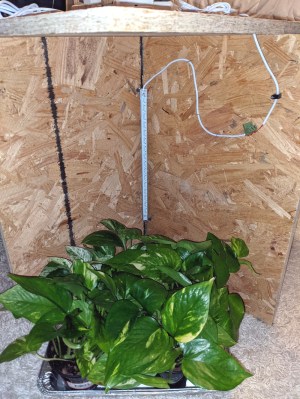It does sound a bit silly — the idea that given enough time, a plant could influence the order of hardware-generated random numbers in order to get enough light to survive. But not so silly that [DeckerM] couldn’t wait to try it out after seeing a short clip about an unpublished study done at Princeton’s Engineering Anomalies Research (PEAR) lab that came to this very conclusion. The actual verbatim conclusion from the clip: “It’s as though life itself – even life or consciousness in something as simple as a house plant, bends probability in the physical world in the direction of what it needs, in the direction of its growth and evolution.”
 The idea is this: a plant is made to suffer by languishing in the corner of a windowless room. The room has exactly one light in the middle of the ceiling — a repositionable spotlight of sorts that can only shine into any of the four corners and is controlled by a random number generator. A set of dividers ensure that none of the light leaks out of the quadrant and into any of the others.
The idea is this: a plant is made to suffer by languishing in the corner of a windowless room. The room has exactly one light in the middle of the ceiling — a repositionable spotlight of sorts that can only shine into any of the four corners and is controlled by a random number generator. A set of dividers ensure that none of the light leaks out of the quadrant and into any of the others.
[DeckerM]’s recreation of this experiment is much more practical. It’s essentially a little plywood cabinet with four open partitions and a ceiling. Each quadrant has a grow light strip planted in the corner, and all the wires are run through the top, where each has been stripped of its pesky power-governing controller and rewired to go straight into a smart plug. [DeckerM] is using a hardware RNG hosted on a Raspberry Pi, which is running a Python script that takes numbers from the RNG that corresponds to one of the quadrants, and then lights that quadrant.
And the results? They don’t really support the PEAR study’s bold conclusion unless viewed in small sample sizes, but [DeckerM] isn’t giving up that easily. Since the paper is unpublished, there are a lot of unanswered questions and juicy variables to play with, like the type, number, and age of the plants used. We’re excited to see if [DeckerM] can shed some light on plant psychokinesis.
Interested in portable plant propagation? A sunny location is usually ideal, but this all-in-one solution can take care of the rest.
















This sort of thing is exactly what theology departments in universities should be doing.
Grant suggestion. If people pray for the plant does it get more light?
So if I tie a plant light to good drops in my favorite roguelite does that mean I’ll finally finish
the game?
imho I think it means your plants are going to die
“It does sound a bit silly — the idea that given enough time, a plant could influence the order of hardware-generated random numbers in order to get enough light to survive.”
Well, I mean… given enough time, given enough trials, SOME plant would grow such that it could screw with the smart plug such that the thing’d stay on. Does that count? Monkeys and Shakespeare, after all.
Tried similar experiments 20+ years ago. Used plants and freshwater crustaceans that are attracted to light. Couldn’t detect any statistical anomaly.
You have to BELIEVE!!!!
Ok.
I thought the random number generation was somehow based on the state of the plant. E.g. entropy generated by resistance(?) meassurements through parts of it or count of leaves or … and the idea was to see wether the plant evolves to influence that entropy in a way that it gets the most beneficial conditions. But that does not seem to be the case.
This is also what I thought initially, I think that would be an interesting study.
Ditto!
Basing it off of soil sensor data would be interesting. Only detect changes the plant has control over, and see if it learns how to control the light at “will’.
too bad the whole “smell sensors” field is so hard; I’d bet on being able to train a plant to control lights that way. Who else has houseplants that say when they want things with scent? Then the trick would be testing how long it takes for a plant to learn different “languages”.
I can see a plant directable feedback mechanism in leaf movement, too; but leaves are short lived and you’d be forever calibrating the senors and have more noise from that than result.
Maybe you could do it with an Interstitial fluid sensor, like diabetics (diabetic humans) use? Chemical changes in interstitial fluid might show plants “desires” which could give the plant what it (we think) it wants, it’s worth a shot.
I can already tell you what the plants want: Brawndo.
It’s got what plants crave.
Well yes, that goes without saying, but what flavour?
Ah yes, PEAR and the likes of the global consciousness project (https://noosphere.princeton.edu). I tinkered a bit with the idea, but using 2 H/W RNG’s and trying to up the correlation outside of the main lobe of the formed binomial distribution. Nada, surprise surprise. Fun ideas, but I think too many people in that crowd buy into quantum woo woo stuff; e.g. the person observing the double slit experiment influences the outcome, it’s not even the observing apparatus, but the one observing the apparatus.
Plants generating and influencing a probability field. See if there’s a range to it.
I posit that over many generations that some plant would adapt to grow on less light and/or become more attuned to the specific frequency of light being emitted. However, it’s more likely the plant would completely short the mechanism long before it modified any complex functionality.
Related, and actually way more cool: Artist Michael Sedbon builds installations to show the biopolitics of plants (competitive algal bioreactors make oxygen to gain access to a limited light resource) https://michaelsedbon.com/CMD
Great link, anybody has similar tips ?
I knew that spinach was cheating when playing dice.
We may need to change some code…
Int getRandomNumber()
{
return 4; // chosen by fair, PLANT FREE, dice roll
// guaranteed to be random
}
https://xkcd.com/221/
life, uh, finds a way.
Well I don’t know about that… but the photoreceptor molecules in plants do seem to be using quantum effects to game the system in favour of energy capture. My rule for judging these things is that useful ideas get used, and or stolen, the rest is snake oil.
The nonspecific term you use, “Quantum effects,” is a pretty obscure way to say you have no idea what you’re talking about.
No that was just you saying that you don’t know what I was talking about.
We can either assume this article’s author is accurate in their opinion or interpretation of the study’s data, or realize that even the slightest deviation from the standard control suggests there is an effect.
“When It Comes to Photosynthesis, Plants Perform Quantum Computation” https://www.scientificamerican.com/article/when-it-comes-to-photosynthesis-plants-perform-quantum-computation/
It would seem that there is no uncertainty as to which of us has no idea.
It would not surprise me if that in some forms of RNG setup (White noise gens maybe) that there was a “squeaky wheel gets the grease” principle at work, through a plant’s electrical impulses (c.f. work illustrating that plants “scream” ) making very low level RFI when the plant is stressed. Ergo plant gets stressed, “screams”, which in consequence of the particular RNG employed, tilts the noise level slightly in it’s favor, it gets watered. This happens a couple of times then the plant adapts to “screaming” sooner, rather than later, to get more water.
Or light rather… was a watering thing done, or am I pulling that from some other things I read decades ago? IDK.
Apparently you need to use the right type of Random Number Generator. ie. One that is based of quantum-indeterminate electronic noise.
Source:
https://noosphere.princeton.edu/reg.html
How many iterations did you do?
Python RNG is not fundementally random, so this experiment was flawed from the get go. The generation source needs to be a true random number generator.